Should We Pump Iron to Slow Climate Change?
March 23, 2007
One of the solutions offered for the global greenhouse gas problem is the fertilization of the ocean; that is, spreading iron into the open ocean to promote the growth of floating microscopic plants. In at least 12 experiments over the past 14 years, researchers have shown that the presence of dissolved iron is critical to blooms of phytoplankton, which draw large amounts of carbon dioxide out of Earth’s atmosphere and deposit a fraction of it in the deep ocean. Some researchers have speculated that we might reduce greenhouse gases by coaxing more marine plants to grow selling it as the oceanic equivalent of planting more trees. However, the value and viability of such iron-enrichment activities, says WHOI marine chemist Ken Buesseler and 22 international colleagues in a recent issue of Science magazine, remains questionable because the artificial addition of iron has provoked very different results in different parts of the world. Iron fertilization on a large scale might promote healthy, useful growth, but it might just as well promote a harvest of oceanic “weeds” such as harmful algal blooms, nutrient pollution, and other unforeseen problems. In a new project funded by the WHOI Ocean and Climate Change Institute, Buesseler and colleagues are planning to deploy instruments off the coast of Cape Verde in late 2007 to measure just how much carbon is sinking from the surface to the seafloor in a part of the ocean that is naturally seeded with iron by dust from the Sahara.

